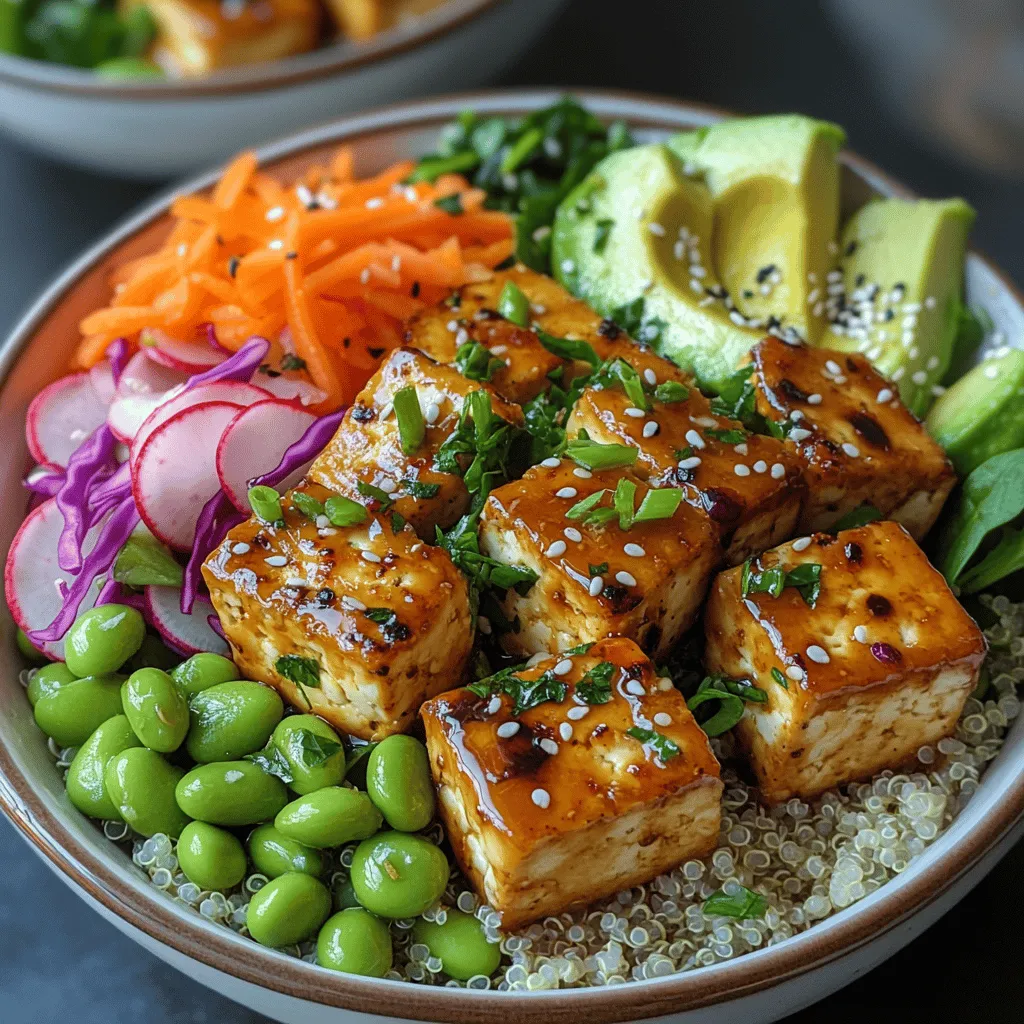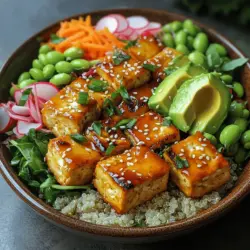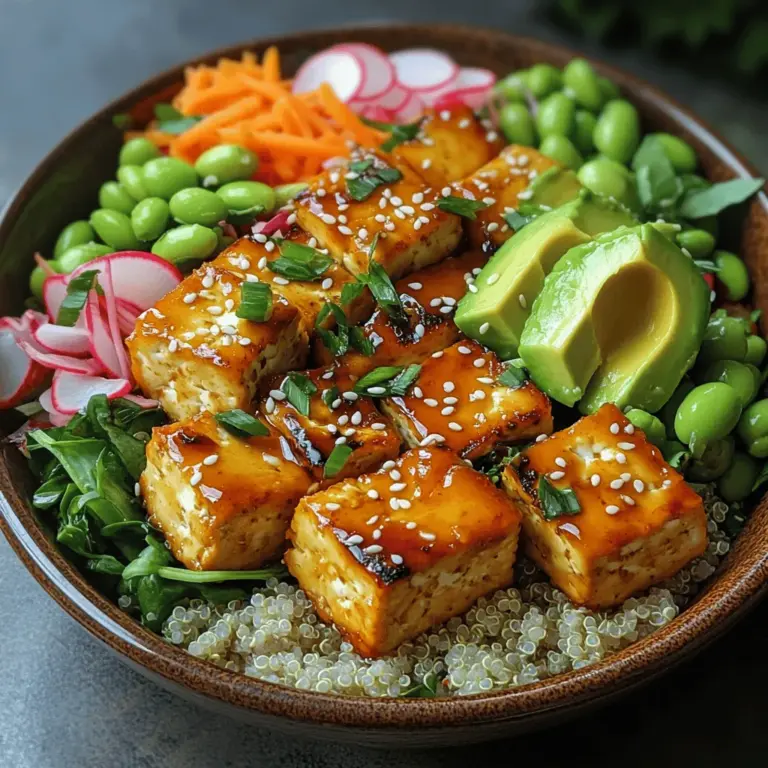Crispy Tofu Buddha Bowls – A Nutritious Delight
In recent years, Buddha bowls have surged in popularity as a go-to health trend, capturing the hearts—and appetites—of food enthusiasts everywhere. These vibrant, nutrient-packed meals are not only visually appealing but also offer a convenient way to enjoy a balanced diet. A Buddha bowl typically comprises a base of grains, a variety of colorful vegetables, a protein source, and a tasty dressing, resulting in a harmonious blend of flavors and textures that satisfy both the palate and the body.
Among the many protein options available, crispy tofu shines as a star ingredient in Buddha bowls. This versatile plant-based protein source is made from soybeans and is cherished in vegetarian and vegan cooking for its ability to absorb flavors and its myriad of culinary applications. When prepared correctly, tofu transforms into a crunchy, golden delight that complements the fresh elements of a Buddha bowl beautifully.
The true beauty of Buddha bowls lies in their adaptability; they can be customized with a colorful array of vegetables and grains that not only enhance the dish’s visual appeal but also provide essential nutrients. Incorporating a variety of colors on your plate can help ensure that you’re consuming a diverse range of vitamins and minerals, promoting overall health and wellness.
In this article, we invite you to explore the recipe for Crispy Tofu Buddha Bowls, a satisfying and nutritious dish that brings together the best of plant-based eating.
Understanding Buddha Bowls
Buddha bowls, often referred to as “grain bowls” or “power bowls,” are believed to have originated from the idea of a “Buddha’s belly,” which symbolizes abundance and nourishment. Traditionally, these bowls are filled to the brim with wholesome ingredients, making them a visual feast that aligns with the principles of mindful eating.
The nutritional benefits of Buddha bowls are vast. A well-constructed bowl incorporates the perfect balance of protein, fiber, healthy fats, and carbohydrates, making it an ideal meal for anyone looking to maintain energy levels and support overall health. The combination of grains, vegetables, and proteins ensures that each bite is packed with essential nutrients that promote satiety and well-being.
Moreover, Buddha bowls allow for creativity and personalization, enabling you to tailor each meal to your specific tastes and dietary needs. Whether you prefer quinoa, brown rice, or a mix of leafy greens as your base, or whether you want to load up on seasonal vegetables, the possibilities are endless.
The Star Ingredient: Tofu
Tofu, a staple in many vegetarian and vegan diets, is made by curdling soy milk and pressing the curds into solid white blocks. This humble ingredient is not only rich in protein but also offers a wealth of health benefits. Firm tofu, in particular, is a favorite for its ability to hold its shape during cooking while absorbing flavors from marinades and sauces.
Nutritionally, firm tofu is a powerhouse. It is low in calories yet high in protein, making it an excellent choice for those looking to increase their protein intake without adding excessive calories. Additionally, tofu is a good source of calcium, iron, and magnesium, contributing to bone health and muscle function. The presence of isoflavones, which are plant compounds with antioxidant properties, further enhances tofu’s appeal as a healthful food choice.
Incorporating tofu into your diet can also support heart health by lowering cholesterol levels and promoting healthy blood pressure. Its versatility allows it to be used in various dishes, from stir-fries to smoothies, making it a valuable addition to any meal plan.
Ingredients Breakdown
To create Crispy Tofu Buddha Bowls, you’ll need a careful selection of ingredients, each serving a unique purpose that contributes to the dish’s overall flavor and nutritional profile:
– Tofu: This is the primary protein source in the recipe. The firm texture of the tofu allows it to be cubed and crisped to perfection, providing a satisfying crunch that contrasts beautifully with the fresh vegetables.
– Cornstarch: This ingredient is crucial for achieving that coveted crispy exterior on the tofu. When coated with cornstarch before frying, the tofu develops a delightful crunch that elevates the overall experience of the Buddha bowl.
– Soy Sauce/Tamari: This flavorful ingredient serves as a marinade for the tofu, enhancing its taste with a savory umami boost. Tamari is a gluten-free alternative to soy sauce, making it suitable for those with dietary restrictions.
– Sesame Oil: A drizzle of sesame oil adds depth and richness to the dish, complementing the nutty flavors of the ingredients. Its aromatic quality enhances the overall taste profile of the bowl.
– Quinoa: As a high-protein grain, quinoa serves as the base of the Buddha bowl, providing essential amino acids and fiber. Its fluffy texture and nutty flavor make it an ideal pairing with the crispy tofu and vegetables.
– Vegetables: A variety of colorful vegetables not only adds nutritional value but also brings visual appeal to the dish. Choose seasonal favorites like bell peppers, carrots, and leafy greens to create a vibrant mix.
– Peanut Sauce: The creamy element of the bowl, peanut sauce adds flavor complexity and richness. Its nutty, slightly sweet profile ties the dish together, making each bite a delightful experience.
– Suggestions for Ingredient Substitutions: For those with specific dietary restrictions, there are numerous substitutions that can be made. For instance, if you are allergic to peanuts, consider using almond butter or tahini as an alternative for the sauce. If quinoa is not available, brown rice or farro can serve as excellent bases for the bowl.
Initial Steps for Preparation
To begin your journey towards creating Crispy Tofu Buddha Bowls, start by gathering all your ingredients and preparing them for cooking. The first step is to press the tofu to remove excess moisture. This is crucial, as it not only helps achieve a crispy texture but also allows the tofu to absorb the flavors of the marinade more effectively.
Once the tofu is pressed, cut it into bite-sized cubes and toss it with cornstarch to ensure an even coating. This step is key to achieving that crispy exterior. Meanwhile, prepare your marinade by combining soy sauce or tamari with sesame oil, garlic, and any other desired seasonings. Allow the tofu to marinate for at least 15-30 minutes to let the flavors infuse.
While the tofu is marinating, cook your quinoa according to package instructions, ensuring fluffy grains for the base of your bowl. Once the quinoa is ready, it will provide a satisfying foundation for the other ingredients.
Next, heat a non-stick skillet over medium-high heat and add a splash of oil. Once hot, carefully add the marinated tofu cubes. Sauté until they are golden and crispy on all sides, which usually takes about 10-15 minutes. The aroma of sizzling tofu will fill your kitchen, setting the stage for the delicious Buddha bowl you are about to assemble.
As the tofu cooks, take this opportunity to chop and prepare your chosen vegetables. Aim for a colorful mix that includes a variety of textures—crunchy, leafy, and tender—to create a visually stunning and nutritionally balanced meal.
With the tofu crisped to perfection and the vegetables prepped, you are well on your way to assembling your Crispy Tofu Buddha Bowl. This dish not only celebrates the vibrant flavors of plant-based ingredients but also serves as a wholesome meal that nourishes both body and mind.
As you continue through the recipe, you will discover how each component contributes to a satisfying culinary experience that is both nutritious and delicious. Stay tuned for the next part, where we will explore the assembly of your Buddha bowl and the finishing touches that will bring this dish to life.

Crispy Tofu Buddha Bowls are a delightful way to pack a wealth of nutrients into a single meal. This recipe not only caters to your taste buds but also provides a colorful array of ingredients that are both satisfying and nourishing. In this section, we will delve into the essential steps for preparing each component of the dish, highlight the nutritional benefits, and provide insights for dietary inclusivity and creativity in your cooking.
Step-by-Step Preparation
Preparing the Tofu
Tofu is the star ingredient in our Buddha bowl, and the way you prepare it can significantly impact its texture and flavor. Here’s how to get perfectly crispy tofu every time:
1. Draining: Start with a block of firm or extra-firm tofu. Remove the tofu from its packaging, and drain off the excess liquid.
2. Pressing: To achieve a firmer texture, press the tofu to remove as much moisture as possible. Place the tofu between two clean kitchen towels or paper towels. Set a heavy object, such as a cast iron skillet or a few cookbooks, on top and let it press for at least 15-20 minutes. This step is crucial for getting that crispy exterior.
3. Cutting: Once pressed, cut the tofu into bite-sized cubes—about 1-inch pieces. This size will allow for even cooking and a satisfying texture.
Coating the Tofu for Crispiness
To ensure the tofu has a delicious, crispy coating, follow these steps:
1. Marinating (Optional): For added flavor, marinate the tofu cubes in a mixture of soy sauce, sesame oil, garlic powder, and a splash of rice vinegar for at least 15 minutes. This step is optional but enhances the overall taste.
2. Coating: In a separate bowl, combine cornstarch, salt, and pepper. Toss the marinated tofu cubes in the cornstarch mixture until evenly coated. The cornstarch will give the tofu that extra crunch when baked.
Baking Instructions for Achieving the Perfect Texture
Now that your tofu is prepped and coated, it’s time to bake it to crispy perfection:
1. Preheat your oven to 400°F (200°C). A hot oven is essential for achieving that golden brown color and crispy texture.
2. Arrange the tofu: Line a baking sheet with parchment paper for easy cleanup. Spread the tofu cubes out in a single layer, ensuring they are not crowded. This allows for even cooking.
3. Bake: Place the baking sheet in the preheated oven and bake for 25-30 minutes, flipping the tofu halfway through. Keep an eye on the tofu during the last few minutes to prevent over-browning. The tofu should be golden and crispy on the outside.
Cooking Quinoa as a Base
Quinoa is a fantastic base for your Buddha bowl, providing protein and a nutty flavor. Here’s how to cook it perfectly:
1. Rinse the quinoa: Start by rinsing 1 cup of quinoa under cold water to remove its natural coating, called saponin, which can make it taste bitter.
2. Cooking: In a medium saucepan, combine the rinsed quinoa with 2 cups of water or vegetable broth for added flavor. Bring to a boil over medium-high heat.
3. Simmer: Once boiling, reduce the heat to low, cover the pot, and let it simmer for about 15 minutes, or until the quinoa has absorbed all the liquid and is fluffy. Remove from heat and let it sit, covered, for an additional 5 minutes before fluffing with a fork.
Assembling the Bowl with Visual Presentation Tips
With your crispy tofu and fluffy quinoa ready, it’s time to assemble your Buddha bowl. Here’s how to do it beautifully:
1. Base Layer: Start by placing a generous scoop of quinoa at the bottom of each bowl. The quinoa serves as a nutritious base that complements the other ingredients.
2. Add Vegetables: Layer in a variety of colorful vegetables. Consider using fresh greens like spinach or kale, roasted sweet potatoes, cherry tomatoes, shredded carrots, and cucumber slices. The key is to aim for a vibrant presentation that entices the eyes.
3. Tofu Placement: Add the crispy tofu cubes on top of the vegetables, ensuring they are evenly distributed for a balanced bite.
4. Garnish: Finish the bowl with garnishes such as avocado slices, chopped herbs (like cilantro or green onions), and sesame seeds for an added crunch.
5. Sauce: Drizzle your favorite sauce over the top—options like tahini dressing, peanut sauce, or a simple balsamic vinaigrette work wonderfully to tie all the flavors together.
Final Touches with Toppings and Sauce
The final touches elevate your Buddha bowl from good to great. Here are some ideas for toppings and sauces:
– Crunchy Toppings: Consider adding roasted chickpeas, sunflower seeds, or crushed nuts for extra texture.
– Sauces: A drizzle of sriracha or a squeeze of fresh lime can add a zesty kick. For a creamier element, try a yogurt-based dressing or a homemade cashew sauce.
– Seasoning: A sprinkle of nutritional yeast can enhance the flavor while providing extra nutrients.
Nutritional Information
One serving of Crispy Tofu Buddha Bowl is not only satisfying but also packed with nutrients. Here’s a breakdown of what you can expect:
– Calories: Approximately 450-500 calories per serving, depending on the ingredients and portion sizes.
– Macronutrients: This bowl typically contains around 20g of protein, 60g of carbohydrates, and 15g of healthy fats.
– Vitamins and Minerals: Rich in vitamins A, C, and K, as well as minerals like calcium, iron, and magnesium.
Health Benefits of Individual Ingredients
– Tofu: A great source of plant-based protein and contains all nine essential amino acids. It is also rich in iron and calcium, making it an excellent choice for vegans and vegetarians.
– Quinoa: Known as a super grain, quinoa is gluten-free, high in protein, and contains significant amounts of fiber, helping to promote digestive health.
– Vegetables: The variety of vegetables contributes to an array of vitamins, antioxidants, and minerals that support overall health.
– Healthy Fats: Ingredients like avocado and nuts provide healthy fats that are essential for brain health and hormone production.
Balanced Diet Integration
Crispy Tofu Buddha Bowls can easily fit into a balanced diet. By incorporating a diverse range of food groups, including whole grains, vegetables, and healthy fats, this meal can provide essential nutrients while keeping you full and satisfied.
Vegan and Gluten-Free Considerations
This recipe is inherently vegan, making it suitable for those following a plant-based diet. Here’s how to adapt it for various dietary needs:
– Gluten-Free: Ensure that all sauces and additional ingredients are labeled gluten-free. For example, opt for tamari instead of regular soy sauce.
– Nut-Free Variations: If you have nut allergies, you can skip the nuts and seeds in the toppings and use sunflower seed butter or tahini instead of nut-based sauces.
Importance of Inclusivity in Recipe Creation
Creating recipes that cater to various dietary restrictions is essential in today’s culinary landscape. By offering alternatives and suggestions, you can make your recipes accessible to a broader audience, ensuring that everyone can enjoy delicious, healthy meals.
Creative Variations and Customizations
To keep your Buddha bowls exciting, consider these creative variations and customizations:
– Seasonal Ingredients: Use seasonal vegetables and fruits for freshness. In fall, try roasted Brussels sprouts and squash; in summer, opt for zucchini and bell peppers.
– Protein Alternatives: Swap out the tofu for other proteins like tempeh, chickpeas, or lentils for a different flavor profile.
– Additional Toppings: Experiment with pickled vegetables, kimchi, or fresh herbs to enhance the flavor and nutrition of your bowl.
– Meal Prepping: Buddha bowls are perfect for meal prep. Prepare larger batches of quinoa and roasted vegetables to store in the fridge. Assemble your bowls daily for a quick, nutritious meal on the go.
Conclusion
Crispy Tofu Buddha Bowls are a celebration of health, color, and flavor. They offer an opportunity to create a meal that is not only visually stunning but also packed with nutrients. The versatility of this dish allows for endless variations, ensuring that you can tailor it to your taste and dietary needs.
Embrace the joy of cooking by taking the time to experiment with different ingredients, sauces, and toppings. By doing so, you’ll not only create a nourishing meal but also enjoy the process of making it. Whether you’re cooking for yourself, family, or friends, these Buddha bowls are sure to impress and satisfy. So gather your ingredients, follow the steps, and delight in the wholesome goodness of your homemade Crispy Tofu Buddha Bowls.


